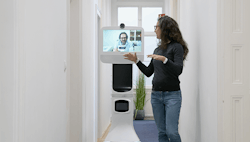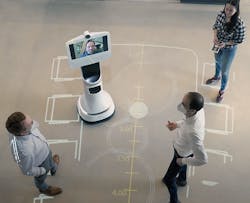Rob Kutner is vice president of sales at Ava Robotics.
Tell us about your company’s state-of-the-art robotics technology?
Rob Kutner, vice president of sales, Ava Robotics: Ava Robotics brings a deep technical heritage, established at iRobot, to define and enable new opportunities for intelligent robots in the workplace. With this technology, its telepresence, UV disinfection and security robots work to improve productivity, safety and quality of life for workers and businesses across industries. Ava's technology emphasizes user experience, safety and autonomous mobility to empower people, while advancing business operations and access to deliver on a vision of robots working with and for people.
Also read: Autonomous mobile robots’ value is more than just speed
Figure 2: Spontaneous, personalized interaction allows for a more immersive, meaningful avenue for people to collaborate and connect.
Ava partners with industry leaders like Cisco and Johnson Controls, as well as higher-education institutions like MIT, to bring intelligent mobility to a broader range of businesses and organizations. Ava’s business-to-business (B2B) enterprise customers come from industries including healthcare, enterprise/corporate, technology, retail, education, manufacturing and hospitality.
As a human-centered, integrated technology, the interpersonal features and benefits of workplace robotics have both operational and cultural impact:
- inclusive, accessible technology that promotes meeting workers and customers where they are
- seamless workplace integration that enhances existing technology capabilities
- greater focus on health and wellness, building workforce trust and confidence.
What have been the biggest improvements to robotics technology in the past five years?
Rob Kutner, vice president of sales, Ava Robotics: In the past two years, specifically, the pandemic has fueled the need for new business thinking, along with utilization of new technologies, including workplace robots.
Figure 3: People-centric technology and design allows for safe, immersive and meaningful interactions, as well as inclusive access.
Mobile and intelligent technologies have powered robots to augment human presence during times of extreme restriction and rapid workplace iteration. Additionally, this technology delivers on reliable, scalable automation for repetitive or dangerous functions that allow humans to focus on higher-level, more-productive work. Intelligent workplace robotics solves not only complex, short-term challenges, but also helps drive operational productivity and cultural sustainability for years to come.
For example, telepresence robots allow people to be more present during virtual interactions, which is now more important than ever (Figure 1). With robotic telepresence, remote users can autonomously navigate to a desired workplace location and interact with others through advanced video conferencing capabilities. Spontaneous, personalized interaction allows for a more immersive, meaningful avenue for people to collaborate and connect (Figure 2).
Engaged workers promote retention. Integration, interoperability and acceptance of telepresence robots help businesses offer a more retainable and satisfying experience in the workplace. People-centric technology and design allows for safe, immersive and meaningful interactions, as well as inclusive access (Figure 3).
What’s the most innovative or efficient robotics technology application you’ve ever seen or been involved with?
Rob Kutner, vice president of sales, Ava Robotics: The pandemic demanded new, urgent protocols, disrupting existing services, processes and communication. Consider the resource, scheduling and availability barriers in workplaces. From hospitals and healthcare facilities to warehouses to conference centers, change was and remains necessary. But this change is a moving target. Ava is excited to play an active role in the innovation erupting across industries.
Figure 4: As a smart, practical solution for hybrid healthcare operations and collaboration, telepresence robots enable telehealth in hospital systems.
For healthcare, mobile, intelligent and autonomous technology provides benefits in two key areas: improving care access and quality of communication within healthcare systems (Figure 4). As a smart, practical solution for hybrid healthcare operations and collaboration, telepresence robots enable telehealth in hospital systems, remote satellite locations, long-term care communities such as assisted living, memory care and hospice, labs/research centers and medical equipment/service workplaces.
Telepresence robots serve to close gaps in healthcare education for hospitals and other care facilities. There is a natural application for new, robust technology in the world of healthcare and clinical simulation, especially when it comes to improving user experience and learning outcomes for healthcare professionals training virtually. Tele-simulation to enable hybrid education, training and assessment, is a growing trend in healthcare.
Robotics also delivers increased productivity, improved access and cost management without sacrificing dynamic human interaction between the medical community, patients and families. The medical world has needs far beyond the scope of pandemic response.
For human resources and employee experience, hybrid work changes hiring conditions and candidate expectations. As distributed candidates prioritize flexibility and choice, technology must elevate the virtual recruiting experience, for both candidates and hiring teams, beyond a static screen.
Intelligent, mobile telepresence robots feature people-centric technology that allows for safe, immersive and meaningful interactions, as well as inclusive access. With recruiting and hiring being one of the most people-forward functions within a business, technology solutions that cross over into this side of the house must be centered around experience. Additionally, employee satisfaction and retention demand long-term virtual technology efficacy.
For disinfection and sanitation, the appetite for UVC disinfection robots in response to the pandemic tracks with the accelerated adoption of other workplace technologies and solutions. Corporate offices, warehouses, hotels, schools, retail locations, a wider range of healthcare facilities—pretty much anywhere business is conducted—place new emphasis on health and safety solutions to benefit employees, customers and clients.
The immediate business benefits of UVC disinfection robots are straightforward: eliminate harmful particles in the air and on surfaces to mitigate spread and contamination. Less obvious are the intangible, long-term benefits UVC robots provide people, places and processes. Mobile UVC robots provide disinfection where HVAC doesn’t circulate air, and automated UVC treatments won’t miss as many spots as human hands.
The complexity of the workplace is presenting in many forms, building a continuous backlog. Focusing on a formal return to work at this point is wasteful. Businesses must solve for and prioritize workplace productivity and health and safety with agility, iterating in real time.
How has robotics technology benefitted from remote monitoring and connectivity?
Rob Kutner, vice president of sales, Ava Robotics: Remote monitoring and connectivity allow robots to make workplaces, facilities and businesses safer, healthier and more efficient. Robotic security applications, for example, can help businesses focus more on response to threats and physical breaches and less on routine observation.
Robots bring efficiencies to security operations while increasing operational competencies beyond security in ways that were once thought impossible. In satisfying monotonous and repeated security tasks, such as observing, reporting and patrolling, with objectivity and precision, security robots can conduct autonomous event response, send automatic alerts, and follow and track suspicious activity.
Workplace robots integrate with other monitoring tools and systems, as well as people managing specific initiatives. This allows for a more comprehensive and efficient solution to workplace challenges. Intelligent workplace robots extend existing technologies, including monitoring and connectivity capabilities, to mobilize a smarter workplace.
Mike Bacidore is the editor in chief for Control Design magazine. He is an award-winning columnist, earning a Gold Regional Award and a Silver National Award from the American Society of Business Publication Editors. Email him at [email protected].
About the Author
Mike Bacidore
Editor in Chief
Mike Bacidore is chief editor of Control Design and has been an integral part of the Endeavor Business Media editorial team since 2007. Previously, he was editorial director at Hughes Communications and a portfolio manager of the human resources and labor law areas at Wolters Kluwer. Bacidore holds a BA from the University of Illinois and an MBA from Lake Forest Graduate School of Management. He is an award-winning columnist, earning multiple regional and national awards from the American Society of Business Publication Editors. He may be reached at [email protected]

Leaders relevant to this article:





